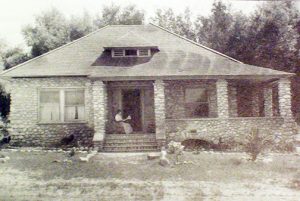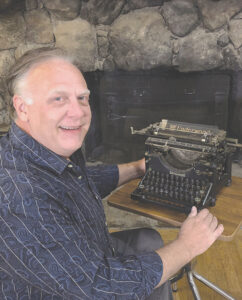Crack! The tremendous moans of the great tree echoed off the canyon walls. Again, crack! The tall timber slowly began to tip. Standing a short distance away was Asa Rowley, holding the handle of an enormous tree saw in one hand. On the other end of the long sharp-toothed saw stood Asa’s son Loron. The floor of the forest lurched as the massive tree crashed to the ground. The hard work of chopping the wood and loading their sled began.
Loron, who I mistakenly identified as Loren two weeks ago, had followed in the footsteps of his two uncles, George and Henry, when he arrived here from Minnesota in 1882. After his trip west on the recently completed transcontinental railway into Los Angeles, he identified 160 acres of government land available for homesteading, north of the city.
Informed of the profitability in beekeeping, Loron purchased several hives, loaded a newly acquired buckboard wagon and began the journey to his new ranch. He passed through Glendale and into the narrows, through the washes and over the hills, finally arriving in the area above the present suburb of Tujunga. By the fall of 1882 Loren was established with his bees and a ranch house, said to have been built with the assistance of the Verdugo family.
He was one of the very first homesteaders in the area and very few others were seen about. An occasional hunter might wander through or perhaps a drover behind his herd of cattle when the grasses in the valley had grown long in the spring. His father Asa and mother Hattie joined him about 1886.
Other visitors to the valley were the woodcutters. From them Loron came to realize the value of the small forest that existed in the shadows of his canyons. He and his father would cut down these trees, stack them on a sled to bring them down the mountain then load up their wagon for a journey downtown. An abundance of oaks and pines were cut down across the San Gabriels to provide the fuel for cooking and heating in Los Angeles.
In 1885, the Monte Vista development started with a great burst of enthusiasm and expenditure; the land was laid out and a hotel was built. Within a year a second, much larger, hotel was under construction. With some skill in carpentry, Loron was able to get work in Monte Vista … and had an inspiration there.
Visitors and workers were buzzing about Monte Vista like the bees around their hives. Loron saw a need and by the end of that year had built a two-story general store just a block from the new hotel, the first such establishment in what is now Sunland.
Loron married Virginia Newcomb in 1894 and over the next 10-plus years had five children – two boys and three girls. During this time, a decision was made to build a second home. They had their ranch house on the old homestead, encompassing the general area of Tujunga’s Seven Hills neighborhood today, and their second home was then built of stone just a block north of their store.

One sweet story that comes down to us through time is that of a special method of communication that Loron and Virginia shared way back then. At times when Loron worked late and needed to be back at the store early he would spend the night in Sunland while Virginia was home on the ranch with the kids. At a special time, prearranged, Virginia would wave a lantern as a signal to Loron down the hill that all was well at the homestead.
Amazingly, the public has an opportunity to visit the former Sunland home of the Rowley family. Bolton Hall Museum will host a historic home tour on Saturday, May 10, and the Rowley House is one of six historic properties featured. For information or tickets visit www.BoltonHall.org.

